From Atmospheric Evolution to the Search of Species of Astrobiological Interest in the Solar System—Case Studies Using the Planetary Spectrum Generator
Abstract
:1. Introduction
1.1. Venus
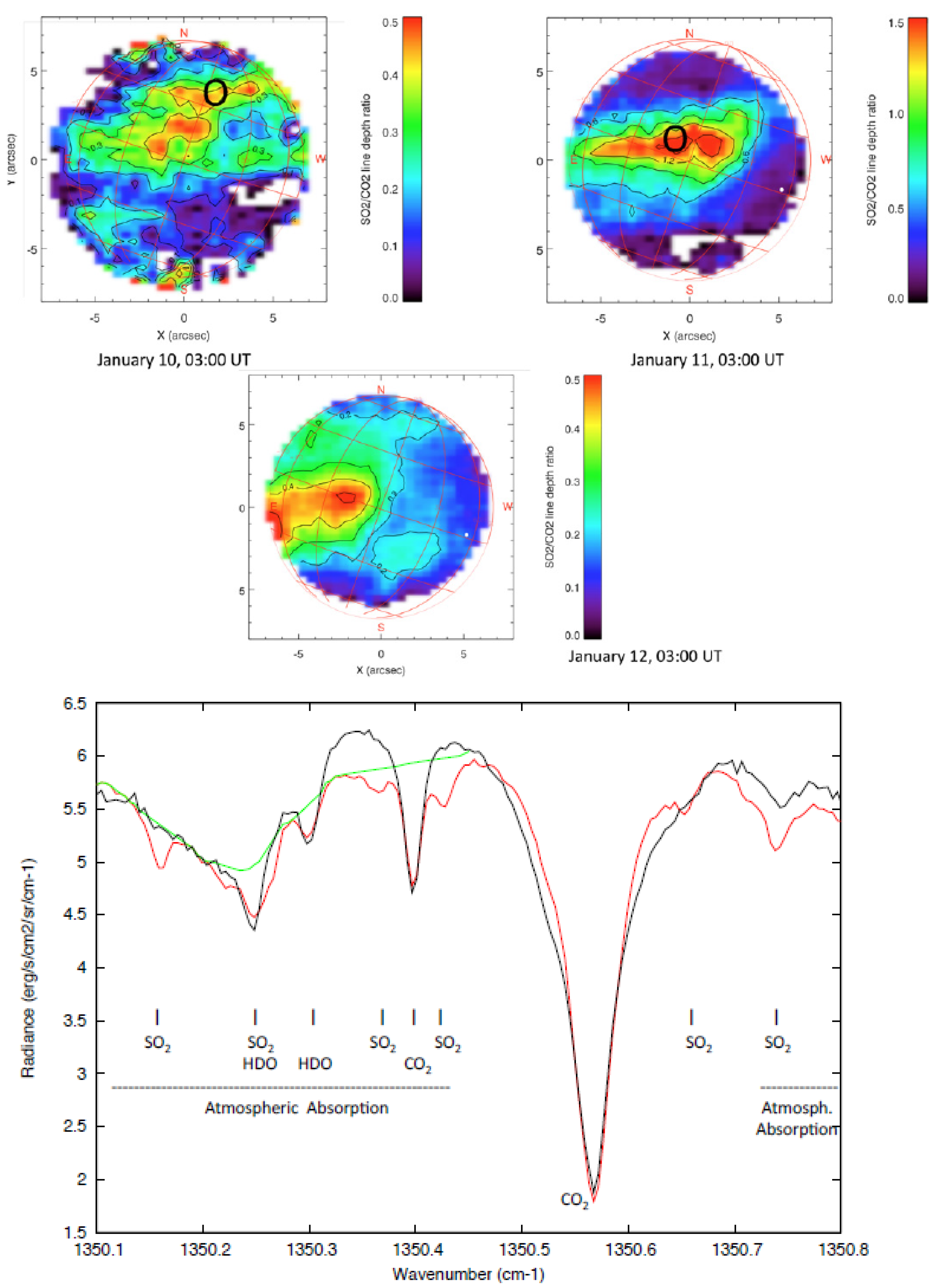
1.2. Mars
1.3. The D/H Ratio
2. Observations
2.1. Venus
2.2. Mars
2.3. Jupiter
3. Methods
3.1. The Planetary Spectrum Generator
3.2. Atmospheric Models
3.3. Detection of Minor Species
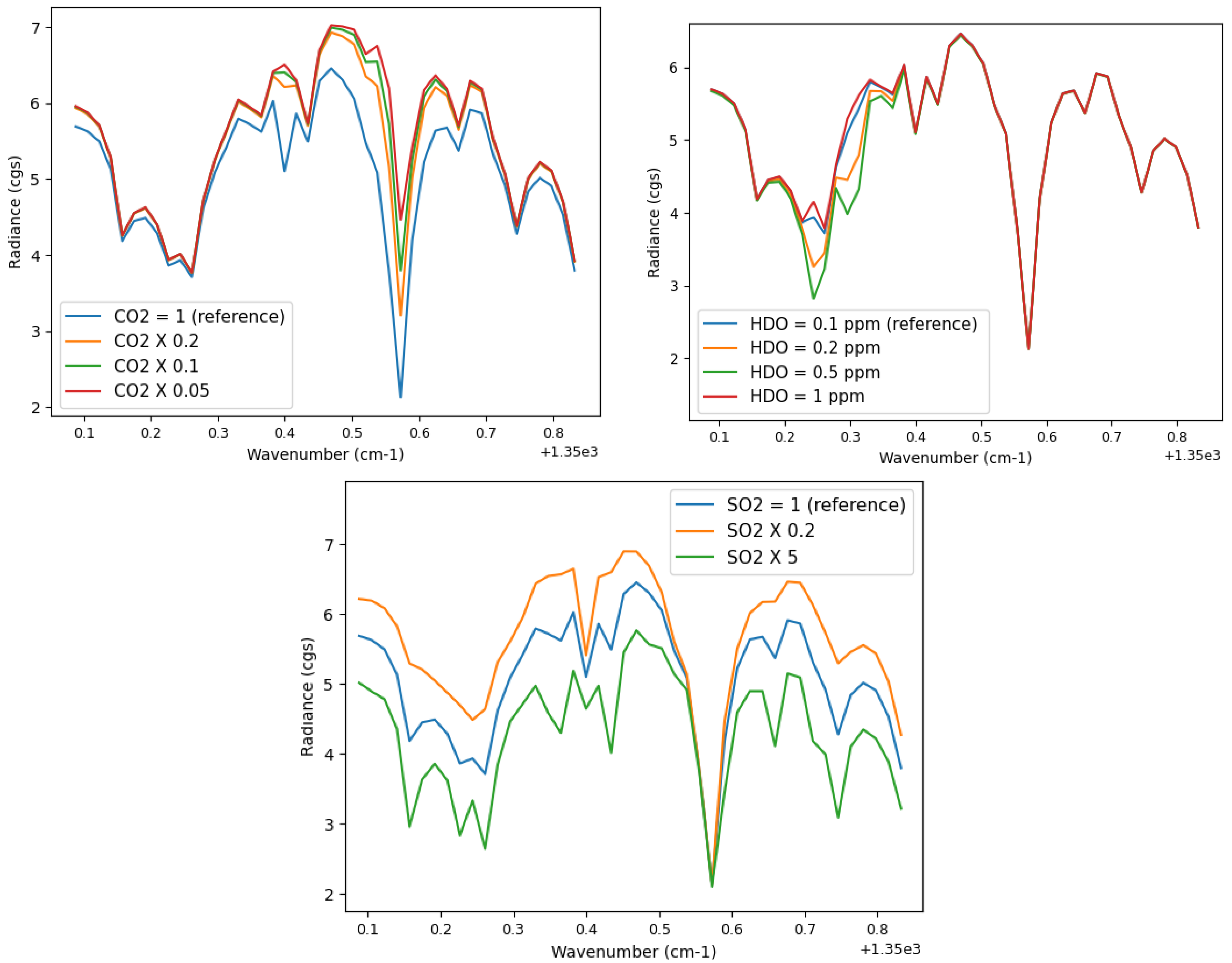
| Line () | PSG | PSG Doppler Corrected | HITRAN |
|---|---|---|---|
| 1 | 1350.159 ± 0.009 | 1350.113 ± 0.009 | —1350.1134 ± 0.0001 |
| 2 | 1350.226 ± 0.009 | 1350.180 ± 0.009 | —1350.1780 ± 0.0001 |
| 3 | 1350.260 ± 0.009 | 1350.214 ± 0.009 | —1350.2138 ± 0.0001 |
| 4 | 1350.310 ± 0.009 | 1350.264 ± 0.009 | HDO—1350.25853 ± 0.00001 |
| 5 | 1350.361 ± 0.009 | 1350.315 ± 0.009 | —1350.3156 ± 0.0001 |
| 6 | 1350.395 ± 0.009 | 1350.349 ± 0.009 | —1350.3519 ± 0.0001 |
| —1350.3470 ± 0.0001 | |||
| 7 | 1350.429 ± 0.009 | 1350.383 ± 0.009 | —1350.3830 ± 0.0001 |
| 8 | 1350.564 ± 0.009 | 1350.518 ± 0.009 | —1350.5250 ± 0.0001 |
| —1350.5100 ± 0.0001 | |||
| 9 | 1350.648 ± 0.009 | 1350.602 ± 0.009 | —1350.6020 ± 0.0001 |
| 10 | 1350.732 ± 0.009 | 1350.686 ± 0.009 | —1350.6867 ± 0.0001 |
3.4. Determination of the Abundances
4. Results
4.1. Sulphur Dioxide on Venus
4.2. Phosphine on Venus
4.3. Methane on Mars
4.4. Determination of the D/H Ratio—Mars
4.5. Detection of Minor Chemical Species on Jupiter
5. Discussion and Conclusions
Author Contributions
Funding
Data Availability Statement
Acknowledgments
Conflicts of Interest
References
- Zhang, X.; Liang, M.C.; Mills, F.P.; Belyaev, D.A.; Yung, Y.L. Sulfur chemistry in the middle atmosphere of Venus. Icarus 2012, 217, 714–739. [Google Scholar] [CrossRef]
- Marcq, E.; Mills, F.P.; Parkinson, C.D.; Vandaele, A.C. Composition and chemistry of the neutral atmosphere of Venus. Space Sci. Rev. 2017, 214, 1. [Google Scholar] [CrossRef] [Green Version]
- Jenkins, J.M.; Kolodner, M.A.; Butler, B.J.; Suleiman, S.H.; Steffes, P.G. Microwave remote sensing of the temperature and distribution of sulfur compounds in the lower atmosphere of Venus. Icarus 2002, 158, 312–328. [Google Scholar] [CrossRef]
- Butler, B. Accurate and consistent microwave observations of Venus and their implications. Icarus 2001, 154, 226–238. [Google Scholar] [CrossRef]
- Oyama, V.I.; Carle, G.C.; Woeller, F.; Pollack, J.B.; Reynolds, R.T.; Craig, R.A. Craig; Pioneer Venus gas chromatography of the lower atmosphere of Venus. J. Geophys. Res. 1980, 85, 7891–7902. [Google Scholar] [CrossRef]
- Marcq, E.; Encrenaz, T.; Bézard, B.; Birlan, M. Remote Sensing of Venus’ lower atmosphere from ground-based IR spectroscopy: Latitudinal and vertical distribution of minor species. Planet. Space Sci. 2005, 54, 1360–1370. [Google Scholar] [CrossRef]
- Jenkins, J.M.; Steffes, P.G.; Hinson, D.P.; Twicken, J.D.; Tyler, G. Leonard; Radio occultation studies of the Venus atmosphere with the Magellan spacecraft. Icarus 1994, 110, 79–94. [Google Scholar] [CrossRef]
- Gubenko, V.N.; Yakovlev, O.I.; Matyugov, S.S. Radio Occultation Measurements of the Radio Wave Absorption and the Sulfuric Acid Vapor Content in the Atmosphere of Venus. Cosm. Res. 2001, 39, 439–445. [Google Scholar] [CrossRef]
- Mallama, A.; Wang, D.; Howard, R.A. Venus phase function and forward scattering from H2SO4. Icarus 2006, 182, 10–22. [Google Scholar] [CrossRef]
- Bézard, B.; Bergh, C.D. Composition of the atmosphere of Venus below the clouds. J. Geophys. Res. 2007, 112, E04S07. [Google Scholar] [CrossRef]
- Zasova, L.; Moroz, V.; Esposito, L.; Na, C. SO2 in the middle atmosphere of Venus: IR measurements from VENERA-15 and comparison to UV data. Icarus 1993, 105, 92–109. [Google Scholar] [CrossRef]
- Marcq, E.; Belyaev, D.; Montmessin, F.; Fedorova, A.; Bertaux, J.-L.; Vandaele, A.C.; Neefs, E. An investigation of the SO2 content of the venusian mesosphere using SPICAV-UV in nadir mode. Icarus 2011, 211, 58–69. [Google Scholar] [CrossRef]
- Encrenaz, T.; Greathouse, T.; Marcq, E.; Sagawa, H.; Widemann, T.; Bézard, B.; Fouchet, T.; Lefèvre, F.; Lebonnois, S.; Atreya, S.; et al. HDO and SO2 thermal mapping on Venus. V. Evidence for a long-term anti-correlation. Astron. Astrophys. 2020, 543, A69. [Google Scholar] [CrossRef]
- Schwieterman, E.; Kiang, N.; Parenteau, M.; Harman, C.; DasSarma, S.; Fisher, T.; Arney, G.; Hartnett, H.; Reinhard, C.; Olson, S.; et al. Exoplanet Biosignatures: A Review of Remotely Detectable Signs of Life. Astrobiology 2018, 18, 663–708. [Google Scholar] [CrossRef] [PubMed]
- Sousa-Silva, C. Phosphine as a Biosignature Gas in Exoplanet Atmospheres. Astrobiology 2020, 20, 235–268. [Google Scholar] [CrossRef] [PubMed]
- Morton, S.C.; Edwards, M. Reduced phosphorus compounds in the environment. Crit. Rev. Environ. Sci. Technol. 2005, 35, 333–364. [Google Scholar] [CrossRef]
- Pasek, M.A.; Sampson, J.M.; Atlas, Z. Redox chemistry in the phosphorus biogeochemical cycle. Proc. Natl. Acad. Sci. USA 2014, 111, 15468–15473. [Google Scholar] [CrossRef] [PubMed] [Green Version]
- Irwin, P. Giant Planets of Our Solar System: Atmospheres, Composition, and Structure; Springer: Berlin, Germany, 2010. [Google Scholar]
- Greaves, J.S.; Richards, A.M.S.; Bains, W.; Rimmer, P.B.; Sagawa, H.; Clements, D.L.; Seager, S.; Petkowski, J.J.; Sousa-Silva, C.; Ranjan, S.; et al. Phosphine gas in the cloud decks of Venus. Nat. Astron. 2020, 5, 655–664. [Google Scholar] [CrossRef]
- Greaves, J.S.; Richards, A.M.S.; Bains, W.; Rimmer, P.B.; Clements, D.L.; Seager, S.; Petkowski, J.J.; Sousa-Silva, C.; Ranjan, S.; Fraser, H.J. Reply to: No evidence of phosphine in the atmosphere of Venus from independent analyses. Nat. Astron. 2021, 5, 636–639. [Google Scholar] [CrossRef]
- Bains, W.; Petkowski, J.J.; Seager, S.; Ranjan, S.; Sousa-Silva, C.; Rimmer, P.B.; Zhan, Z.; Greaves, J.S.; Richards, A.M. Phosphine on Venus cannot be explained by conventional processes. Astrobiology 2021, 21, 1277–1304. [Google Scholar] [CrossRef]
- Encrenaz, T.; Greathouse, T.; Marcq, E.; Widemann, T.; Bézard, B.; Fouchet, T.; Giles, R.; Sagawa, H.; Greaves, J.; Sousa-Silva, C. A stringent upper limit of the PH3 abundance at the cloud top of Venus. Astron. Astrophys. 2020, 643, L5. [Google Scholar] [CrossRef]
- Encrenaz, T.; Greathouse, T.K.; Roe, H.G.; Richter, M.J.; Lacy, J.H.; Bézard, B.; Fouchet, T.; Widemann, T. HDO and SO2 thermal mapping on Venus: Evidence for strong SO2 variability. Astron. Astrophys. 2012, 543, A153. [Google Scholar] [CrossRef] [Green Version]
- Krasnopolsky, V.A.; Maillard, J.P.; Owen, T.C. Detection of methane in the martian atmosphere: Evidence for life? Icarus 2004, 172, 537–547. [Google Scholar] [CrossRef]
- Giuranna, M.; Viscardy, S.; Daerden, F.; Neary, L.; Etiope, G.; Oehler, D.; Formisano, V.; Aron-ica, A.; Wolkenberg, P.; Aoki, S.; et al. Independent confirmation of a methane spike on Mars and a source region east of gale crater. Nat. Geosci. 2019, 12, 326–332. [Google Scholar] [CrossRef]
- Korablev, O.; Vandaele, A.C.; Montmessin, F.; Fedorova, A.A.; Trokhimovskiy, A.; Forget, F.; Lefèvre, F.; Daerden, F.; Thomas, I.R.; Trompet, L.; et al. No detection of methane on Mars from early ExoMars Trace Gas Orbiter observations. Nature 2019, 568, 517–520. [Google Scholar] [CrossRef] [PubMed]
- Etiope, G.; Oehler, D.Z. Methane spikes, background seasonality and non-detections on Mars: A geological perspective. Planet. Space Sci. 2019, 168, 52–61. [Google Scholar] [CrossRef]
- Moores, J.E.; Gough, R.V.; Martinez, G.M.; Meslin, P.-Y.; Smith, C.L.; Atreya, S.K.; Mahaffy, P.R.; Newman, C.E.; Webster, C.R. Methane seasonal cycle at Gale Crater on Mars consistent with regolith adsorption and diffusion. Nat. Geosci. 2019, 12, 321–325. [Google Scholar] [CrossRef]
- Moores, J.E.; King, P.L.; Smith, C.L.; Martinez, G.M.; Newman, C.E.; Guzewich, S.D.; Meslin, P.; Webster, C.R.; Mahaffy, P.R.; Atreya, S.K.; et al. The methane diurnal variation and microseepage flux at Gale Crater, Mars as constrained by the ExoMars trace gas orbiter and Curiosity Observations. Geophys. Res. Lett. 2019, 46, 9430–9438. [Google Scholar] [CrossRef]
- Knutsen, E.W.; Villanueva, G.L.; Liuzzi, G.; Crismani, M.M.; Mumma, M.J.; Smith, M.D.; Vandaele, A.C.; Aoki, S.; Thomas, I.R.; Daerden, F.; et al. Comprehensive investigation of Mars methane and organics with ExoMars/NOMAD. Icarus 2021, 357, 114266. [Google Scholar] [CrossRef]
- Webster, C.R.; Mahaffy, P.R.; Pla-Garcia, J.; Rafkin, S.C.R.; Moores, J.E.; Atreya, S.K.; Flesch, G.J.; Malespin, C.A.; Teinturier, S.M.; Kalucha, H.; et al. Day-night differences in Mars methane suggest nighttime containment at Gale crater. Astron. Astrophys. 2021, 650, A166. [Google Scholar] [CrossRef]
- Montmessin, F.; Korablev, O.I.; Trokhimovskiy, A.; Lefèvre, F.; Fedorova, A.A.; Baggio, L.; Irbah, A.; Lacombe, G.; Olsen, K.S.; Braude, A.S.; et al. A stringent upper limit of 20 pptv for methane on Mars and constraints on its dispersion outside Gale crater. Astron. Astrophys. 2021, 650, A140. [Google Scholar] [CrossRef]
- Encrenaz, T.; Roques, F.; Bibring, J.-P.; Zarka, P.; Blanc, M.; Barucci, M.-A. The Solar System; Dunlop, S., Translator; Springer: Berlin/Heidelberg, Germany; New York, NY, USA, 2010. [Google Scholar]
- Encrenaz, T.; Dewitt, C.; Richter, M.J.; Greathouse, T.K.; Fouchet, T.; Montmessin, F.; Lefèvre, F.; Bézard, B.; Atreya, S.K.; Aoki, S.; et al. New measurements of D/H on Mars using Exes aboard SOFIA. Astron. Astrophys. 2018, 612, A112. [Google Scholar] [CrossRef] [Green Version]
- Villanueva, G.L.; Liuzzi, G.; Crismani, M.M.J.; Aoki, S.; Vandaele, A.C.; Daerden, F.; Smith, M.D.; Mumma, M.J.; Knutsen, E.W.; Neary, L.; et al. Water heavily fractionated as it ascends on marsas revealed by ExoMars/NOMAD. Sci. Adv. 2021, 7, eabc8843. [Google Scholar] [CrossRef]
- Sánchez-Lavega, A. An Introduction to Planetary Atmospheres; CRC Press: Boca Raton, FL, USA, 2011. [Google Scholar]
- Vago, J.L.; Westall, F.; Pasteur Instrument Teams; Landing Site Selection Working Group; Coates, A.J.; Jaumann, R.; Korablev, O.; Ciarletti, V.; Mitrofanov, I.; Josset, J.-L.; et al. Habitability on early Mars and the search for biosignatures with the ExoMars Rover. Astrobiology 2017, 17, 471–510. [Google Scholar] [CrossRef] [PubMed]
- Greenwood, J.P.; Itoh, S.; Sakamoto, N.; Vicenzi, E.; Yurimoto, H. Hydrogen isotope evidence for loss of water from Mars through Time. Geophys. Res. Lett. 2008, 35, 5. [Google Scholar] [CrossRef] [Green Version]
- Usui, T.; Alexander, C.; Wang, J.; Simon, J.I.; Jones, J.H. Origin of water and mantle–crust interactions on Mars inferred from hydrogen isotopes and volatile element abundances of olivine-hosted melt inclusions of primitive shergottites. Earth Planet. Sci. Lett. 2012, 357–358, 119–129. [Google Scholar] [CrossRef]
- Mahaffy, P.R.; Webster, C.R.; Stern, J.C.; Brunner, A.E.; Atreya, S.K.; Conrad, P.G.; Domagal-Goldman, S.; Eigenbrode, J.L.; Flesch, G.J.; Christensen, L.E.; et al. The imprint of atmospheric evolution in the D/H of Hesperian Clay Minerals on Mars. Science 2015, 347, 412–414. [Google Scholar] [CrossRef] [Green Version]
- Novak, R.E.; Mumma, M.J.; Villanueva, G.L. Measurement of the isotopic signatures of water on Mars; implications for studying methane. Planet. Space Sci. 2011, 59, 163–168. [Google Scholar] [CrossRef]
- Villanueva, G.L.; Mumma, M.J.; Novak, R.E.; Käufl, H.U.; Hartogh, P.; Encrenaz, T.; Tokunaga, A.; Khayat, A.; Smith, M.D. Strong water isotopic anomalies in the martian atmosphere: Probing current and Ancient Reservoirs. Science 2015, 348, 218–221. [Google Scholar] [CrossRef] [Green Version]
- Krasnopolsky, V.A. Variations of the HDO/H2O ratio in the martian atmosphere and loss of water from Mars. Icarus 2015, 257, 377–386. [Google Scholar] [CrossRef]
- Aoki, S.; Nakagawa, H.; Sagawa, H.; Giuranna, M.; Sindoni, G.; Aronica, A.; Kasaba, Y. Seasonal variation of the HDO/H2O ratio in the atmosphere of Mars at the middle of northern spring and beginning of Northern Summer. Icarus 2015, 260, 7–22. [Google Scholar] [CrossRef]
- Encrenaz, T.; DeWitt, C.; Richter, M.J.; Greathouse, T.K.; Fouchet, T.; Montmessin, F.; Lefèvre, F.; Forget, F.; Bézard, B.; Atreya, S.K.; et al. A map of D/H on Mars in the thermal infrared using EXES aboard SOFIA. Astron. Astrophys. 2016, 586, A62. [Google Scholar] [CrossRef]
- Owen, T.; Maillard, J.P.; de Bergh, C.; Lutz, B.L. Deuterium on Mars: The Abundance of HDO and the Value of D/H. Science 1988, 240, 1767. [Google Scholar] [CrossRef] [PubMed]
- Donahue, T.M.; Hodges, R.R. Past and present water budget of Venus. J. Geophys. Res. 1992, 97, 6083–6091. [Google Scholar] [CrossRef]
- Fedorova, A.; Korablev, O.; Vandaele, A.-C.; Bertaux, J.-L.; Belyaev, D.; Mahieux, A.; Neefs, E.; Wilquet, W.V.; Drummond, R.; Montmessin, F.; et al. HDO and H2O vertical distributions and isotopic ratio in the Venus mesosphere by Solar Occultation at Infrared spectrometer on board Venus Express. J. Geophys. Res. 2008, 113, E5. [Google Scholar] [CrossRef] [Green Version]
- Gettelman, A.; Webster, C.R. Simulations of water isotope abundances in the upper troposphere and lower stratosphere and implications for stratosphere troposphere exchange. J. Geophys. Res. 2005, 110, 17301. [Google Scholar] [CrossRef] [Green Version]
- Villanueva, G.L.; Mumma, M.J.; Bonev, B.P.; Novak, R.E.; Barber, R.J.; DiSanti, M.A. Water in planetary and cometary atmospheres: H2O/HDO transmittance and fluorescence models. J. Quant. Spectrosc. Radiat. Transf. 2012, 113, 202–220. [Google Scholar] [CrossRef] [Green Version]
- Webster, C.R.; Mahaffy, P.R.; Atreya, S.K.; Flesch, G.J.; Mischna, M.A.; Meslin, P.-Y.; Farley, K.A.; Conrad, P.G.; Christensen, L.E.; Pavlov, A.A.; et al. Mars methane detection and variability at Gale Crater. Science 2015, 347, 415–417. [Google Scholar] [CrossRef] [Green Version]
- Albert, S.; Bauerecker, S.; Boudon, V.; Brown, L.R.; Champion, J.P.; Loëte, M.; Nikitin, A.; Quack, M. Global Analysis of the high resolution infrared spectrum of methane 12CH4 in the region from 0 to 4800 cm−1. Chem. Phys. 2008, 356, 131–146. [Google Scholar] [CrossRef]
- Mumma, M.J.; Villanueva, G.L.; Novak, R.E.; Hewagama, T.; Bonev, B.P.; DiSanti, M.A.; Mandell, A.M.; Smith, M.D. Strong Release of Methane on Mars in Northern Summer 2003. Science 2009, 323, 1041–1045. [Google Scholar] [CrossRef] [Green Version]
- Encrenaz, T.; Drossart, P.; Feuchtgruber, H.; Lellouch, E.; Bézard, B.; Fouchet, T.; Atreya, S. The atmospheric composition and structure of Jupiter and Saturn from ISO observations: A preliminary review. Planet. Space Sci. 1999, 47, 1225–1242. [Google Scholar] [CrossRef] [Green Version]
- Villanueva, G.; Smith, M.; Protopapa, S.; Faggi, S.; Mandell, A. Planetary spectrum generator: An accurate online radiative transfer suite for atmospheres, comets, small bodies and exoplanets. J. Quant. Spectrosc. Radiat. Transf. 2018, 217, 86–104. [Google Scholar] [CrossRef] [Green Version]
- Gordon, I.E.; Rothman, L.S.; Hargreaves, R.J.; Hashemi, R.; Karlovets, E.V.; Skinner, F.M.; Conway, E.K.; Hill, C.; Kochanov, R.V.; Tan, Y.; et al. The HITRAN 2020 molecular spectroscopic database. J. Quant. Spectrosc. Radiat. Transf. 2021, 277, 107949. [Google Scholar] [CrossRef]
- Rodger, C.D. Inverse Methods for Atmospheric Sounding: Theory and Practice; World Scientific: Singapore, 2008. [Google Scholar]
- Gilli, G.; Lebonnois, S.; González-Galindo, F.; López-Valverde, M.A.; Stolzenbach, A.; Lefèvre, F.; Chaufray, J.Y.; Lott, F. Thermal structure of the upper atmosphere of Venus simulated by a ground-to-thermosphere GCM. Icarus 2017, 281, 55–72. [Google Scholar] [CrossRef]
- Garate-Lopez, I.; Lebonnois, S. Latitudinal variation of clouds’ structure responsible for Venus’ cold collar. Icarus 2018, 314, 1–11. [Google Scholar] [CrossRef] [Green Version]
- Zasova, L.V.; Moroz, V.I.; Linkin, V.M.; Khatuntsev, I.V.; Maiorov, B.S. Structure of the Venusian atmosphere from surface up to 100 km. Cosm. Res. 2006, 44, 364–383. [Google Scholar] [CrossRef]
- Forget, F.; Hourdin, F.; Fournier, R.; Hourdin, C.; Talagrand, O.; Collins, M.; Lewis, S.R.; Read, P.L.; Huot, J.-P. Improved general circulation models of the Martian atmosphere from the surface to above 80 km. J. Geophys. Res. 1999, 104, 24155–24175. [Google Scholar] [CrossRef]
- Millour, E.; Forget, F.; Vals, A.S.M.; Zakharov, V.; Montabone, L.; Montmessin, F.L.F.; Chaufray, J.-Y.; López-Valverde, M.A.; González-Galindo, F.; Lewis, S.R.; et al. The Mars Climate Database (Version 5.3). In Proceedings of the Scientific Workshop: “From Mars Express to ExoMars”, Madrid, Spain, 27–28 February 2018. [Google Scholar]
- Irwin, P.G.J.; Teanby, N.A.; de Kok, R.; Fletcher, L.N.; Howett, C.J.A.; Tsang, C.C.C.; Wilson, C.F.; Calcutt, S.B.; Nixon, C.A.; Parrish, P.D. The NEMESIS planetary atmosphere radiative transfer and retrieval tool. J. Quant. Spectrosc. Rad. Trans. 2008, 109, 1136–1150. [Google Scholar] [CrossRef]
- Henningsen, J.; Barbe, A.; De Backer-Barilly, M.-R. Revised molecular parameters for 32SO2 and 34SO2 from high resolution study of the infrared spectrum in the 7–8 μm wavelength region. J. Quant. Spectrosc. Radiat. Transf. 2008, 109, 2491–2510. [Google Scholar] [CrossRef]
- Underwood, D.S.; Tennyson, J.; Yurchenko, S.N.; Huang, X.; Schwenke, D.W.; Lee, T.J.; Clausen, S.; Fateev, A. ExoMol molecular line lists—XIV. The rotation-vibration spectrum of hot SO2. Mon. Not. R. Astron. Soc. 2016, 459, 3890–3899. [Google Scholar] [CrossRef] [Green Version]
- Zak, E.; Tennyson, J.; Polyansky, O.L.; Lodi, L.; Zobov, N.F.; Tashkun, S.A.; Perevalov, V.I. A room temperature CO2 line list with ab initio computed intensities. J. Quant. Spectrosc. Radiat. Transf. 2016, 177, 31–42. [Google Scholar] [CrossRef] [Green Version]
- Tashkun, S.A.; Perevalov, V.I.; Gamache, R.R.; Lamouroux, J. CDSD-296 high resolution carbon dioxide spectroscopic databank: An update. J. Quant. Spectrosc. Radiat. Transf. 2019, 228, 124–131. [Google Scholar] [CrossRef]
- Kyuberis, A.A.; Zobov, N.F.; Naumenko, O.V.; Voronin, B.A.; Polyansky, O.L.; Lodi, L.; Liu, A.; Hu, S.-M.; Tennyson, J. Room temperature line lists for deuterated water. J. Quant. Spectrosc. Radiat. Transf. 2017, 203, 175–185. [Google Scholar] [CrossRef]
- Encrenaz, T.; Greathouse, T.K.; Richter, M.J.; Bézard, B.; Fouchet, T.; Lefèvre, F.; Montmessin, F.; Forget, F.; Lebonnois, S.; Atreya, S.K.; et al. Simultaneous mapping of H2O and H2O2 on Mars from infrared high-resolution imaging spectroscopy. Icarus 2008, 195, 547–556. [Google Scholar] [CrossRef]
- Brown, L.R.; Sams, R.L.; Kleiner, I.; Cottaz, C.; Sagui, L. Line intensities of the phosphine dyad at 10 μm. J. Mol. Spectrosc. 2002, 215, 178–203. [Google Scholar] [CrossRef]
- Lefèvre, F.; Forget, F. Observed variations of methane on Mars unexplained by known atmospheric chemistry and physics. Nature 2009, 460, 720–723. [Google Scholar] [CrossRef]
- Mischna, M.A.; Allen, M.; Richardson, M.I.; Newman, C.E.; Toigo, A.D. Atmospheric modeling of Mars methane surface releases. Planet. Space Sci. 2011, 59, 227–237. [Google Scholar] [CrossRef]
- Villanueva, G.L.; Cordiner, M.; Irwin, P.G.J.; de Pater, I.; Butler, B.; Gurwell, M.; Milam, S.N.; Nixon, C.A.; Luszcz-Cook, S.H.; Wilson, C.F.; et al. No evidence of phosphine in the atmosphere of Venus from independent analyses. Nat. Astron. 2020, 5, 631–635. [Google Scholar] [CrossRef]
- Atreya, S.K.; Mahaffy, P.R.; Wong, A.-S. Methane and related trace species on Mars: Origin, loss, implications for life, and Habitability. Planet. Space Sci. 2007, 55, 358–369. [Google Scholar] [CrossRef]
- Farrell, W.M.; Delory, G.T.; Atreya, S.K. Martian dust storms as a possible sink of atmospheric methane. Geophys. Res. Lett. 2006, 33, 21. [Google Scholar] [CrossRef] [Green Version]
- Jensen, S.J.K.; Skibsted, J.; Jakobsen, H.J.; Kate, I.L.T.; Gunnlaugsson, H.P.; Merrison, J.P.; Finster, K.; Bak, E.; Iversen, J.J.; Kondrup, J.C.; et al. A sink for methane on Mars? The answer is blowing in the wind. Icarus 2014, 236, 24–27. [Google Scholar] [CrossRef]
- DeLory, G.T.; Farrell, W.M.; Atreya, S.K.; Renno, N.O.; Wong, A.-S.; Cummer, S.A.; Sentman, D.D.; Marshall, J.R.; Rafkin, S.C.; Catling, D.C. Oxidant Enhancement in Martian Dust Devils and Storms: Storm Electric Fields and Electron Dissociative Attachment. Astrobiology 2006, 6, 51–52. [Google Scholar] [CrossRef] [PubMed]
- Atreya, S.K.; Wong, A.-S.; Renno, N.O.; Farrell, W.M.; DeLory, G.T.; Sentman, D.D.; Cummer, S.A.; Marshall, J.R.; Rafkin, S.C.R.; Catling, D. Oxidant Enhancement in Martian Dust Devils and Storms: Implications for Life and Habitability. Astrobiology 2006, 6, 439–450. [Google Scholar] [CrossRef] [Green Version]
- Atreya, S.K.; Witasse, O.; Chevrier, V.F.; Forget, F.; Mahaffy, P.R.; Price, P.B.; Webster, C.R.; Zurek, R.W. Methane on Mars: Current observations, interpretation, and future plans. Planet. Space Sci. 2011, 59, 133–136. [Google Scholar] [CrossRef]
- Atreya, S.K.; Encrenaz, T.; Korablev, O.; Mahaffy, P.R.; Moores, J.E.; Vandaele, A.C.; Webster, C.R.; Meslin, P.; Navarro-Gonzalez, R. Methane on Mars from MSL-Curiosity and ExoMars-Trace Gas Orbiter: A Destructive Role of Surface Oxidants? In Proceedings of the Ninth International Conference on Mars, Pasadena, CA, USA, 22–25 July 2019. LPI Contribution No. 2089, id.6067. [Google Scholar]
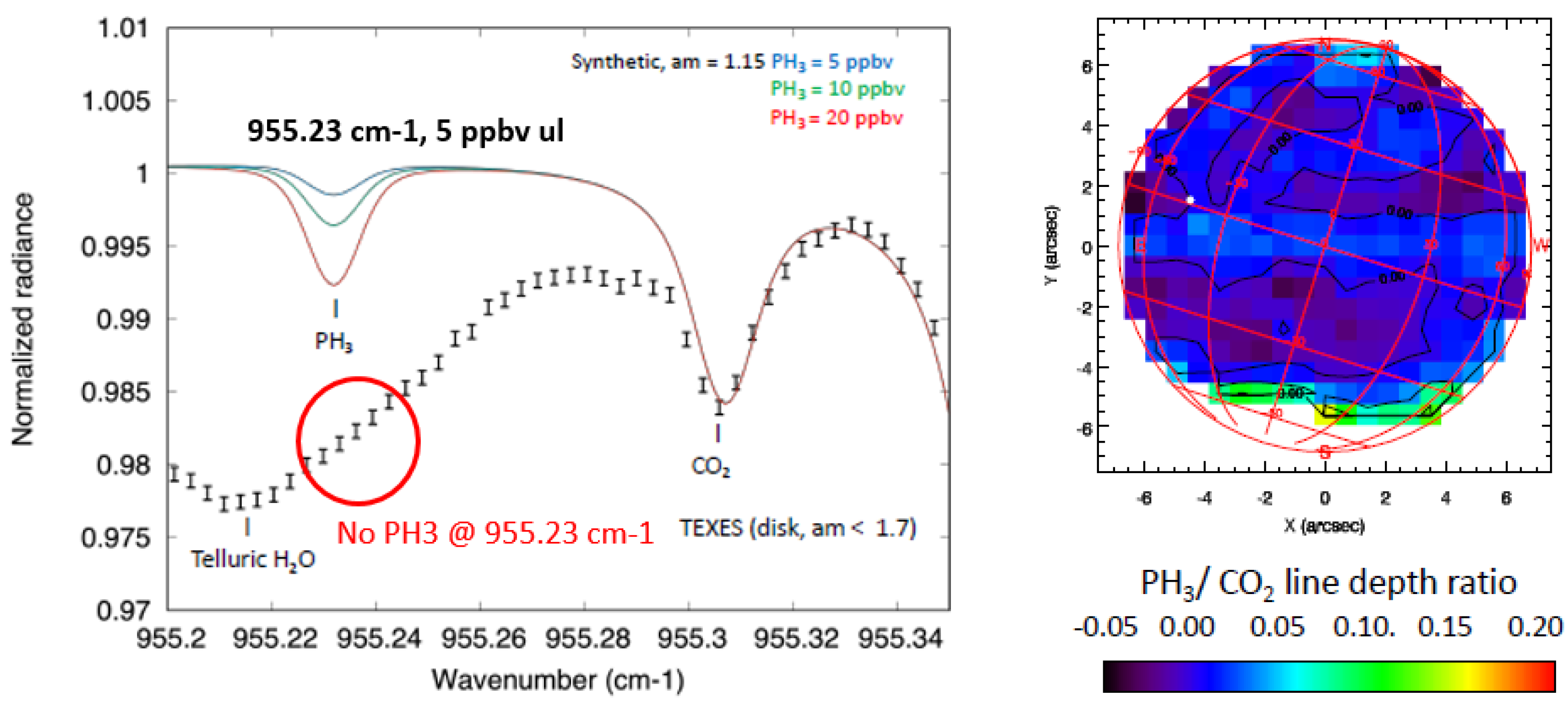
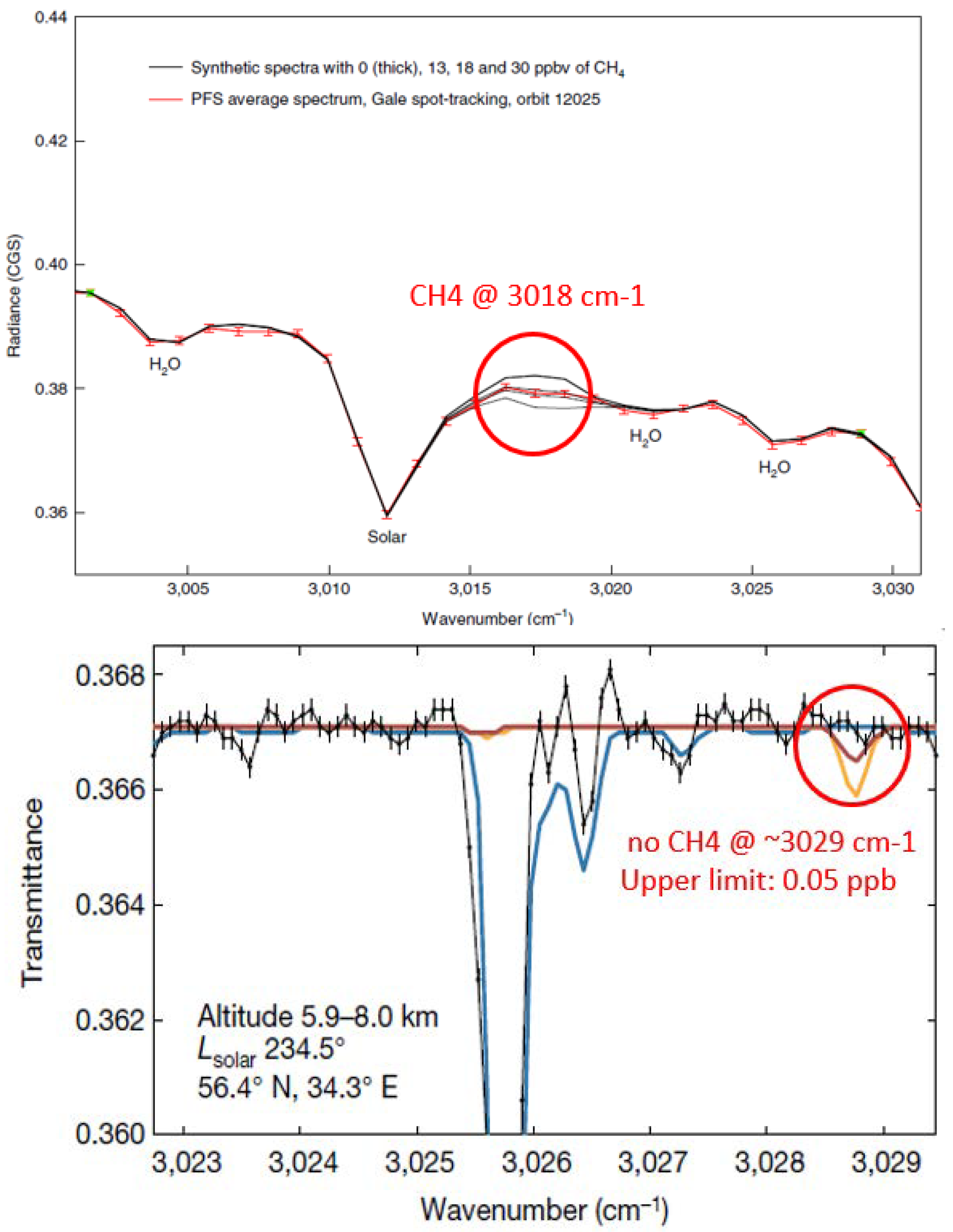
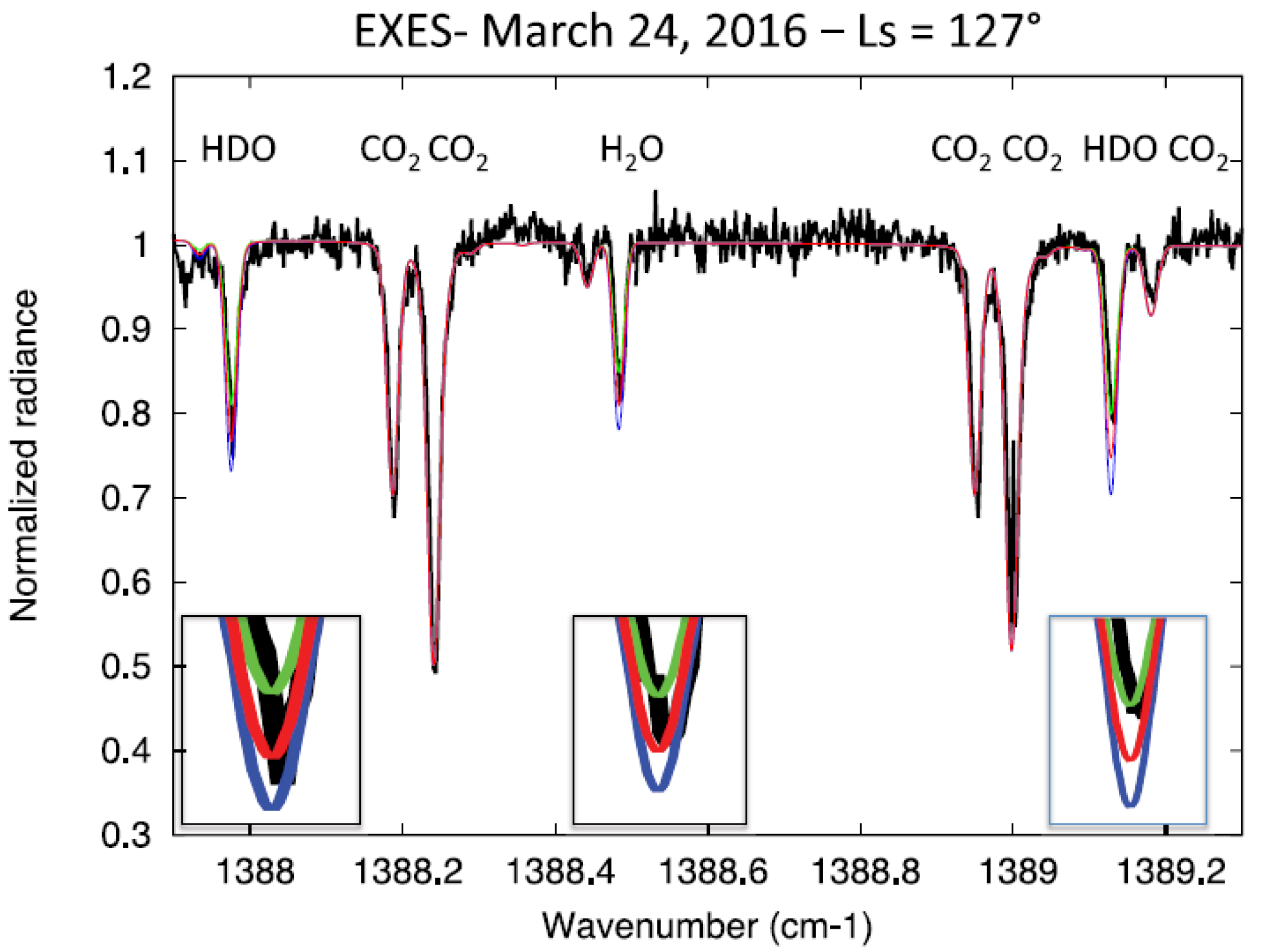
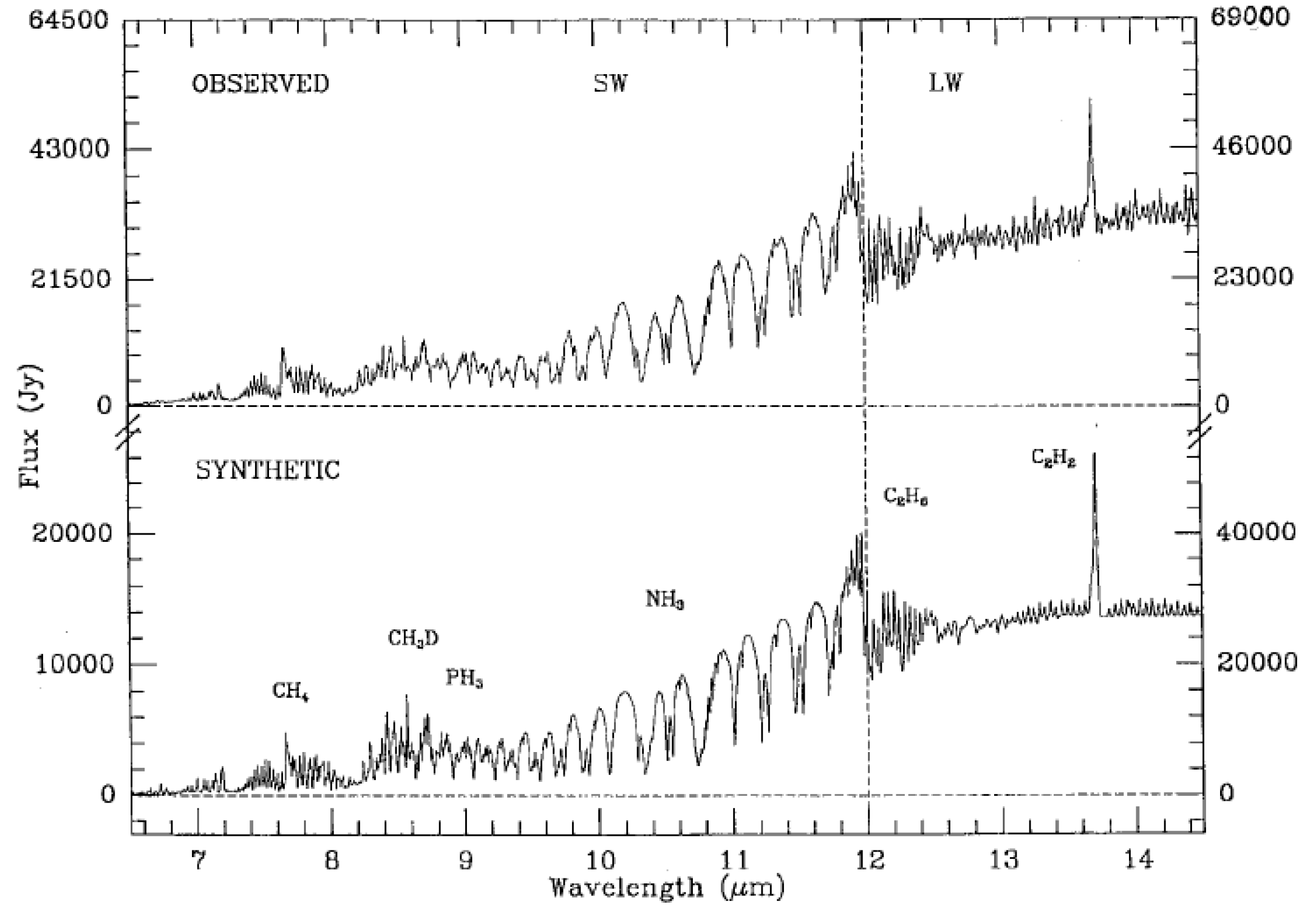
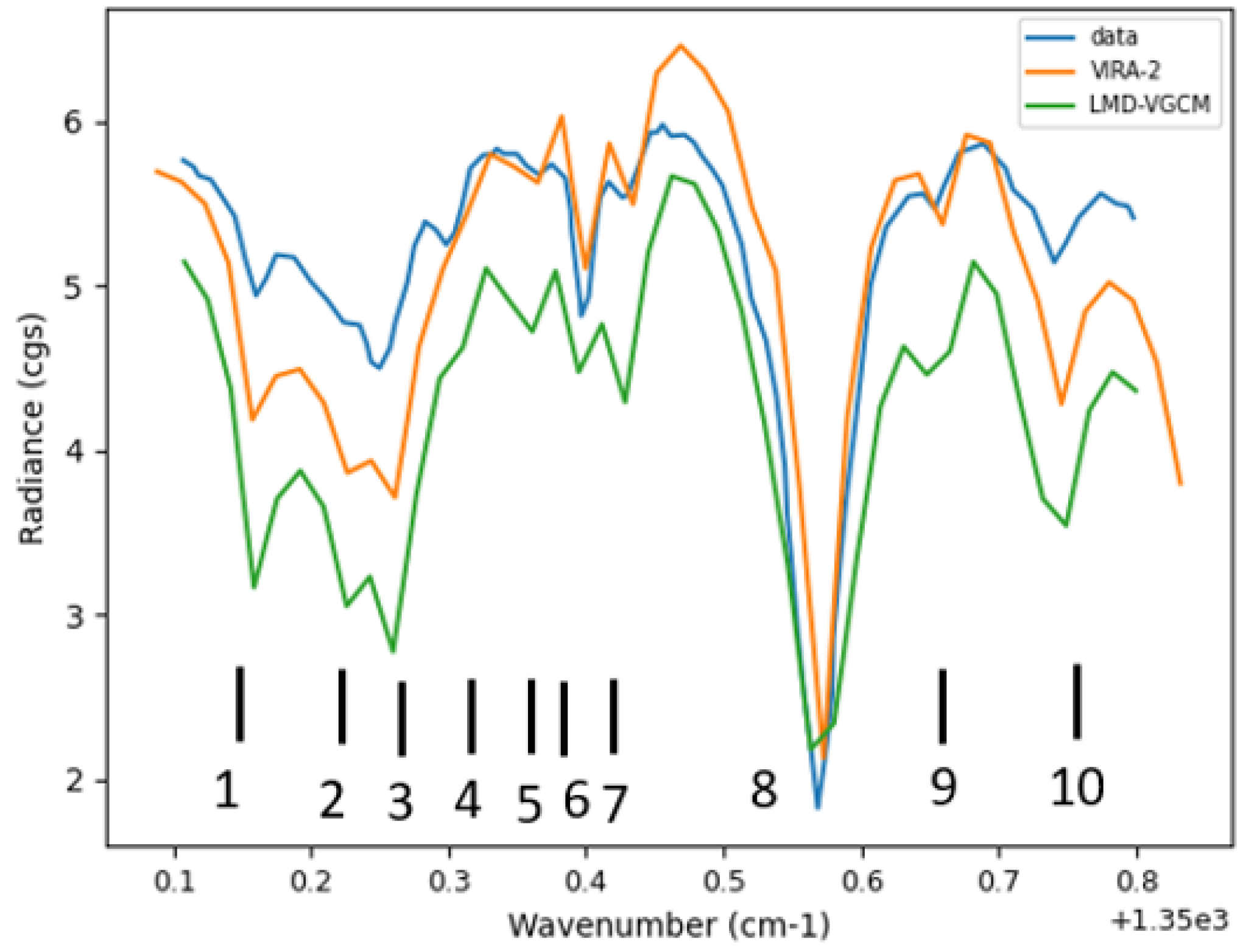

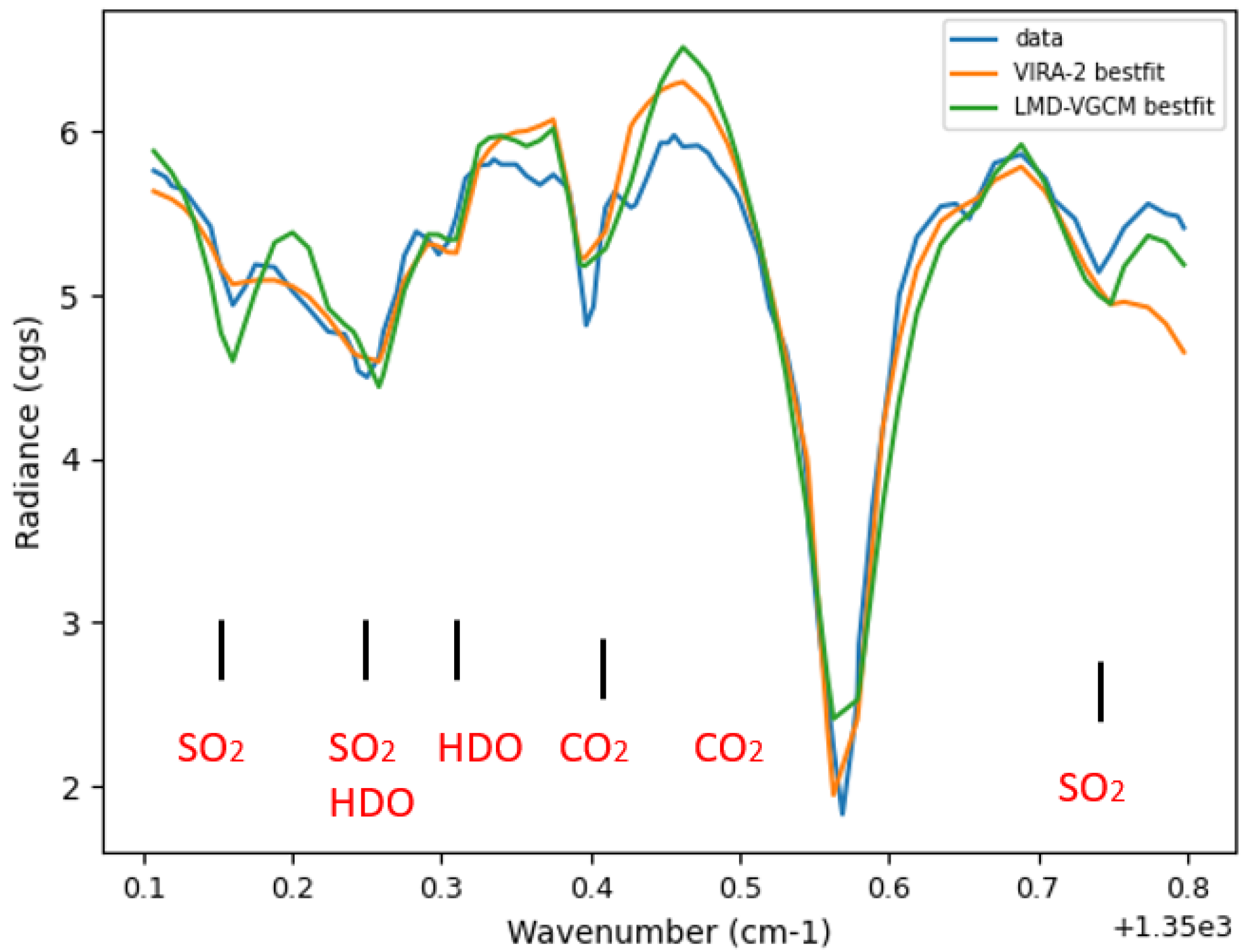
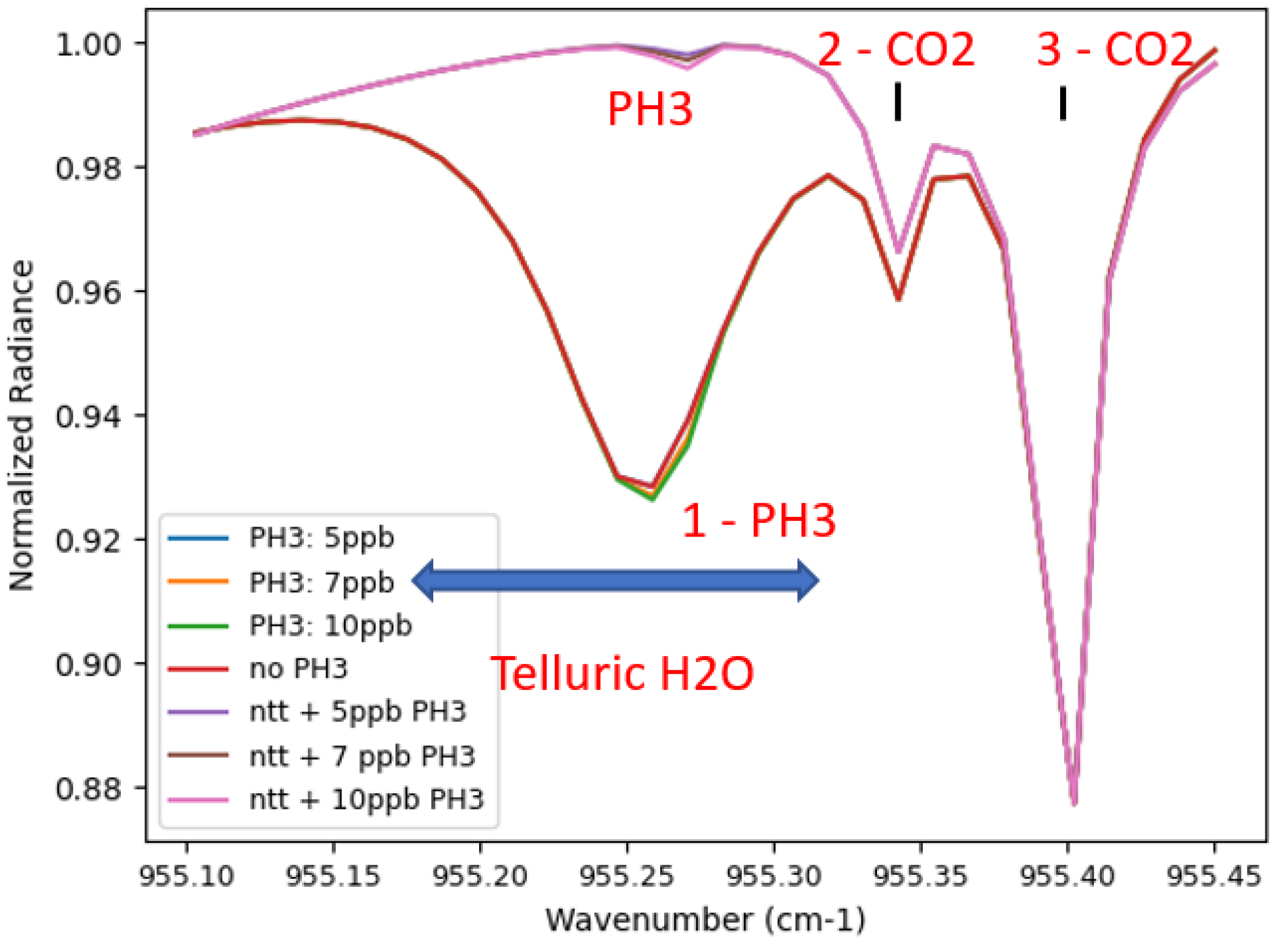
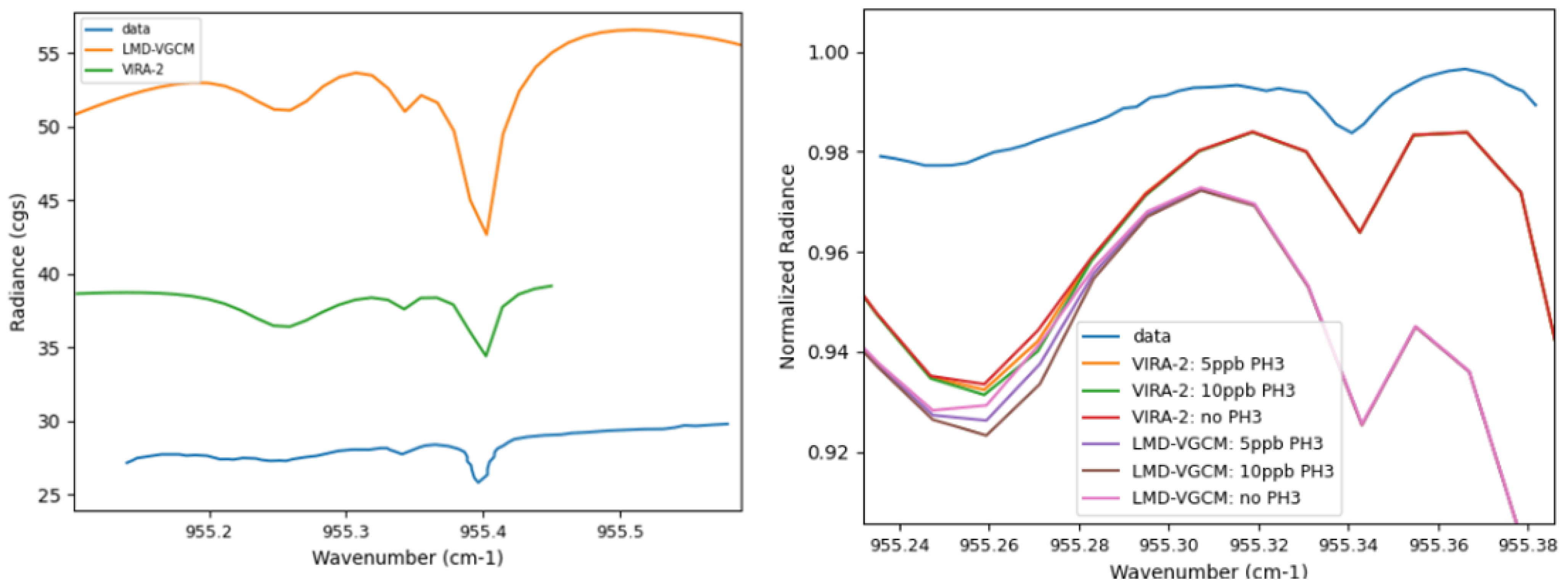
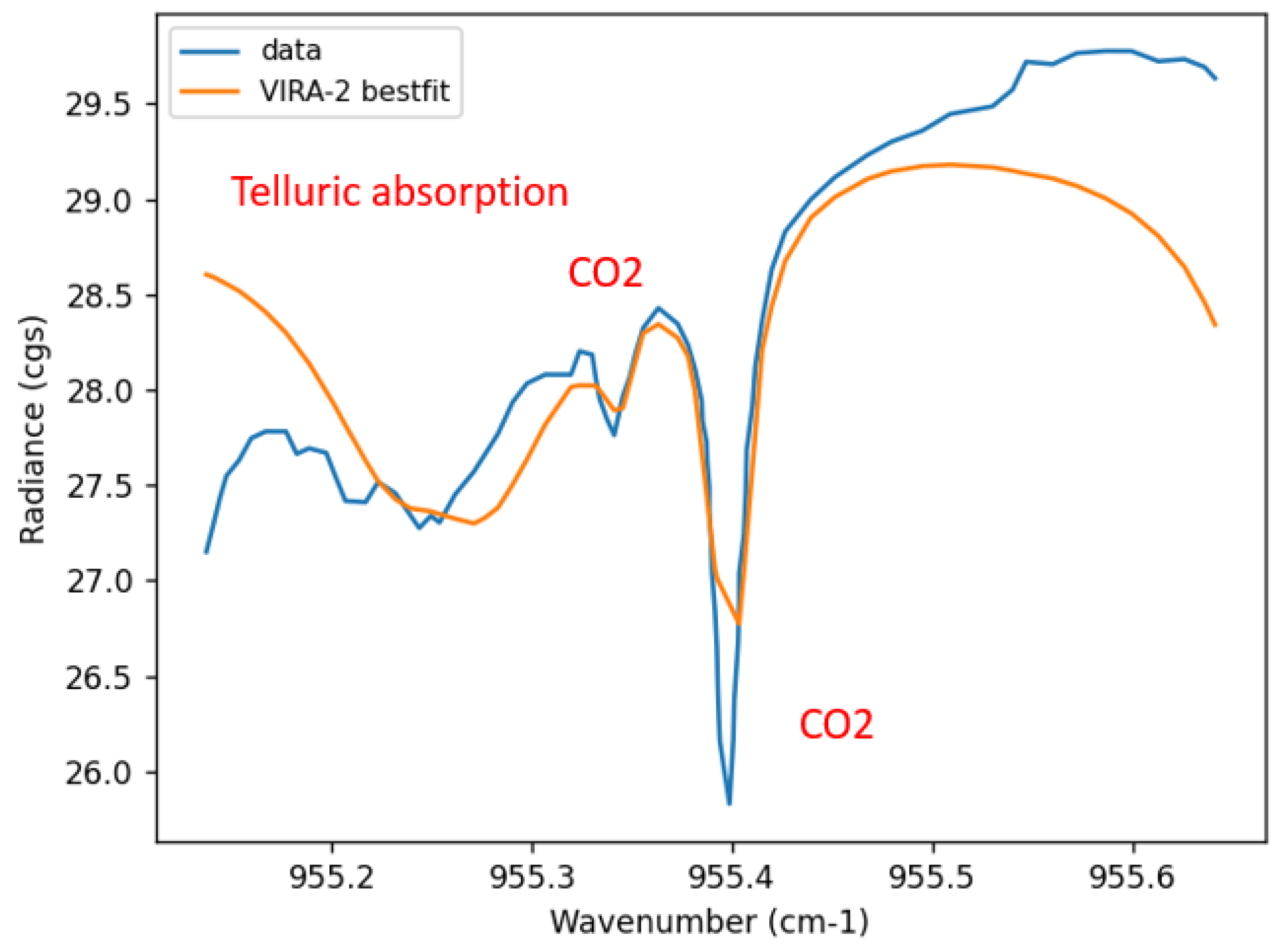
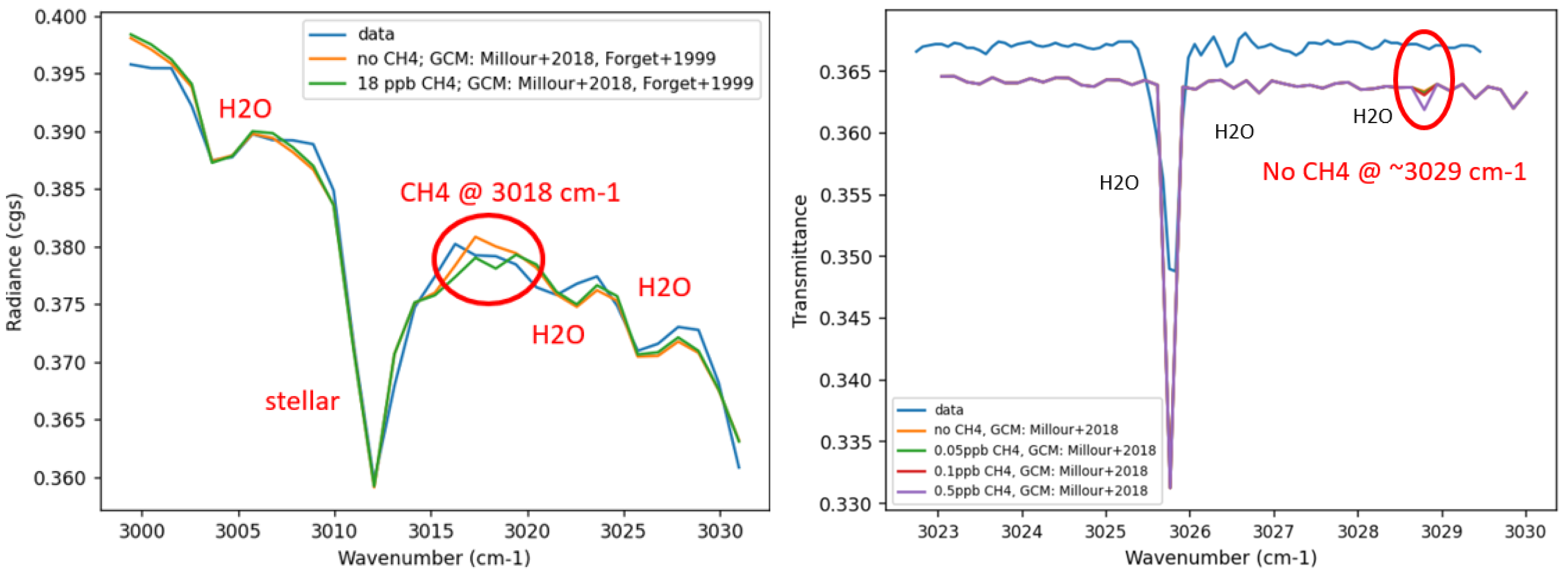
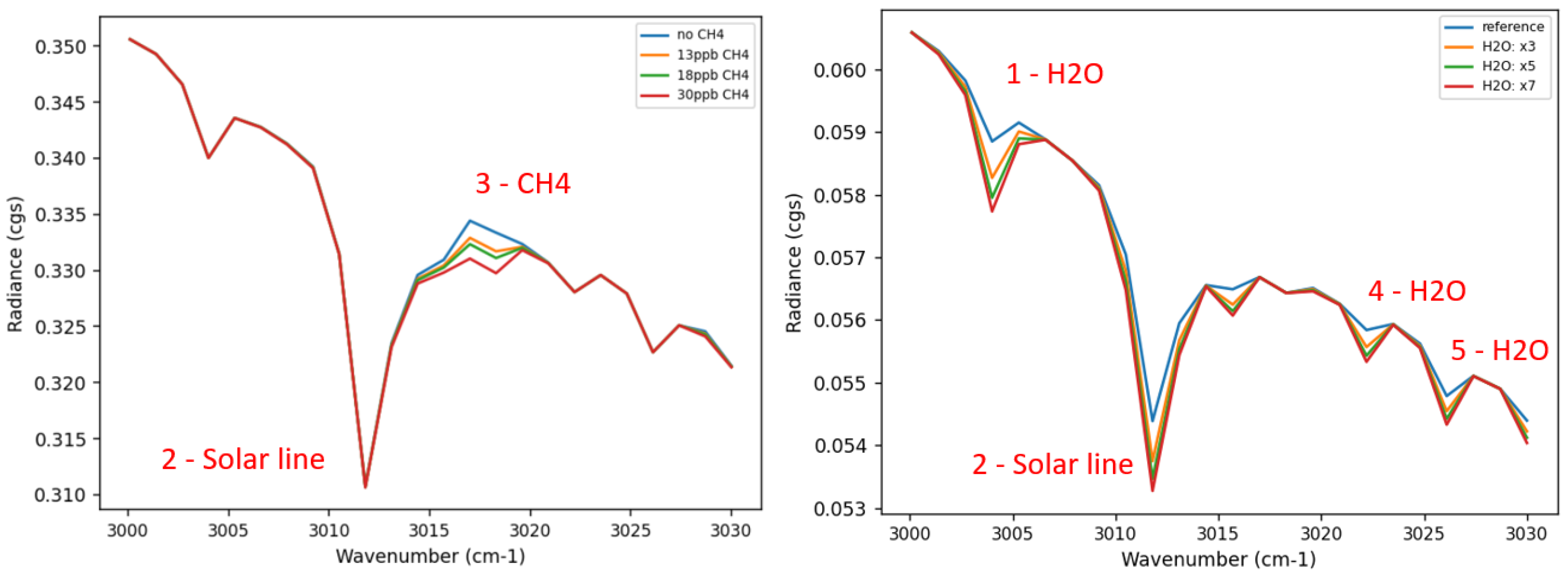
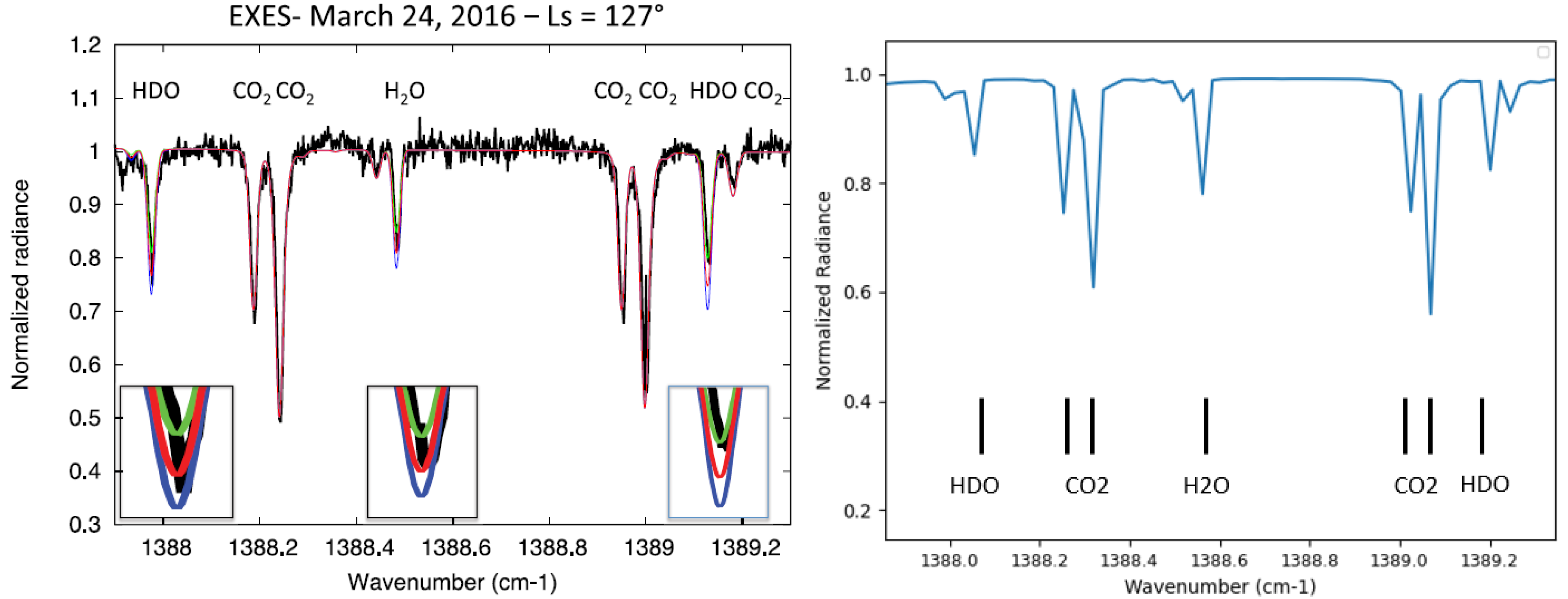
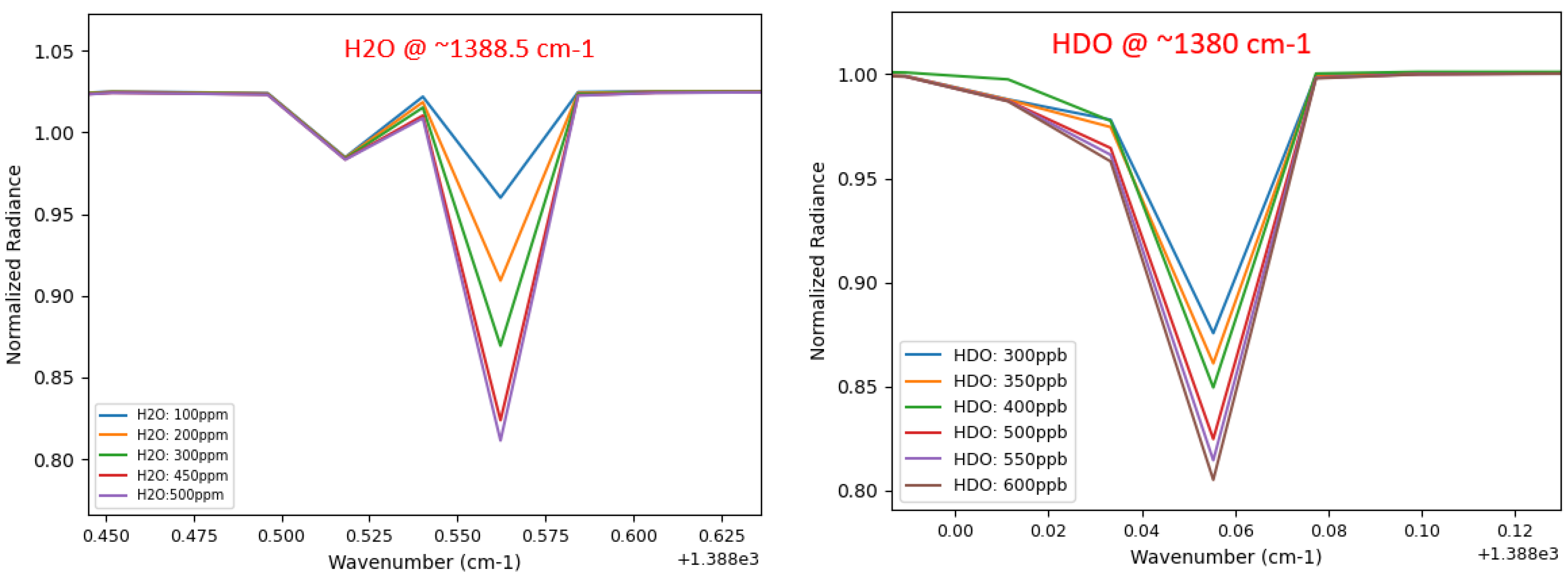
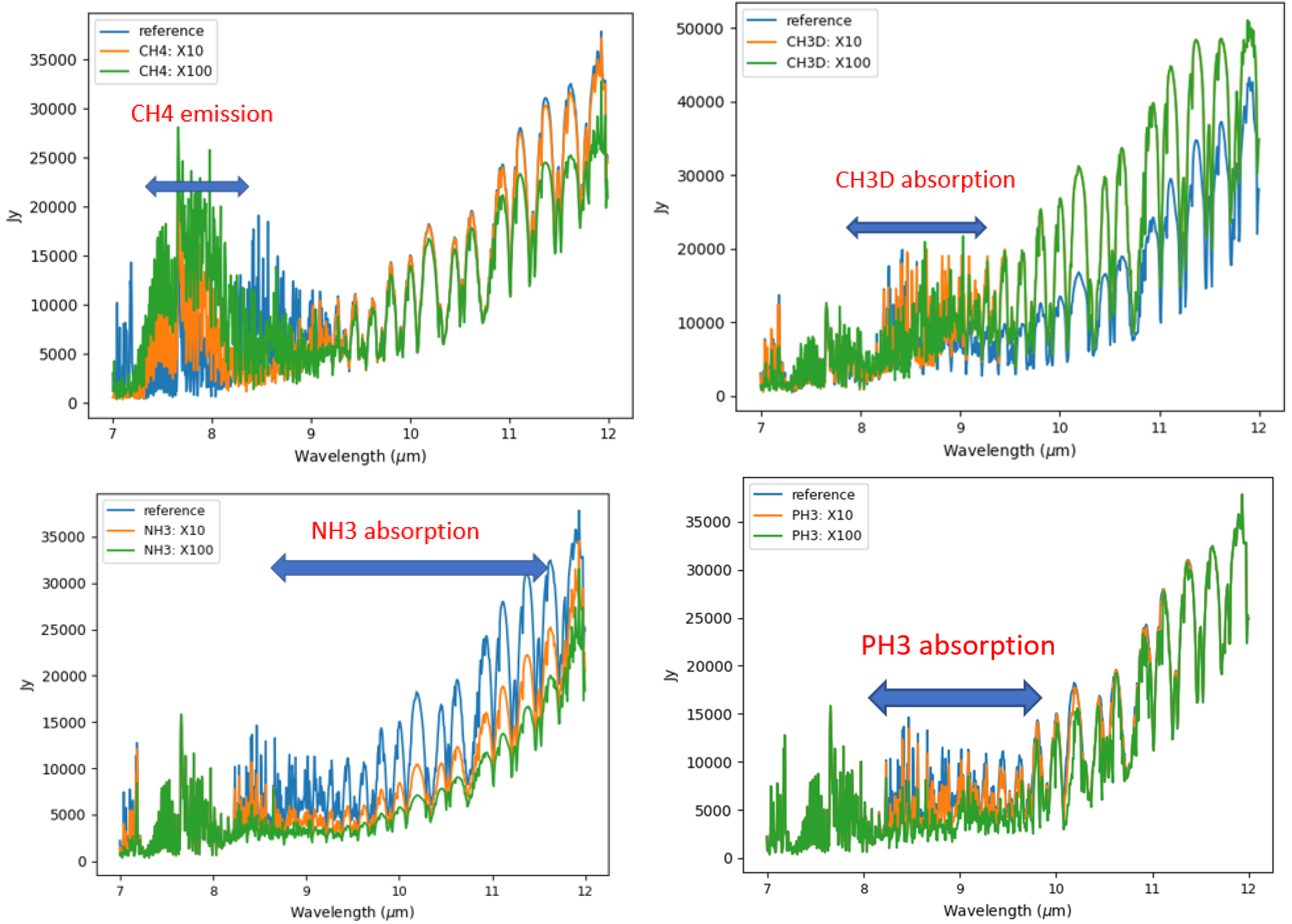
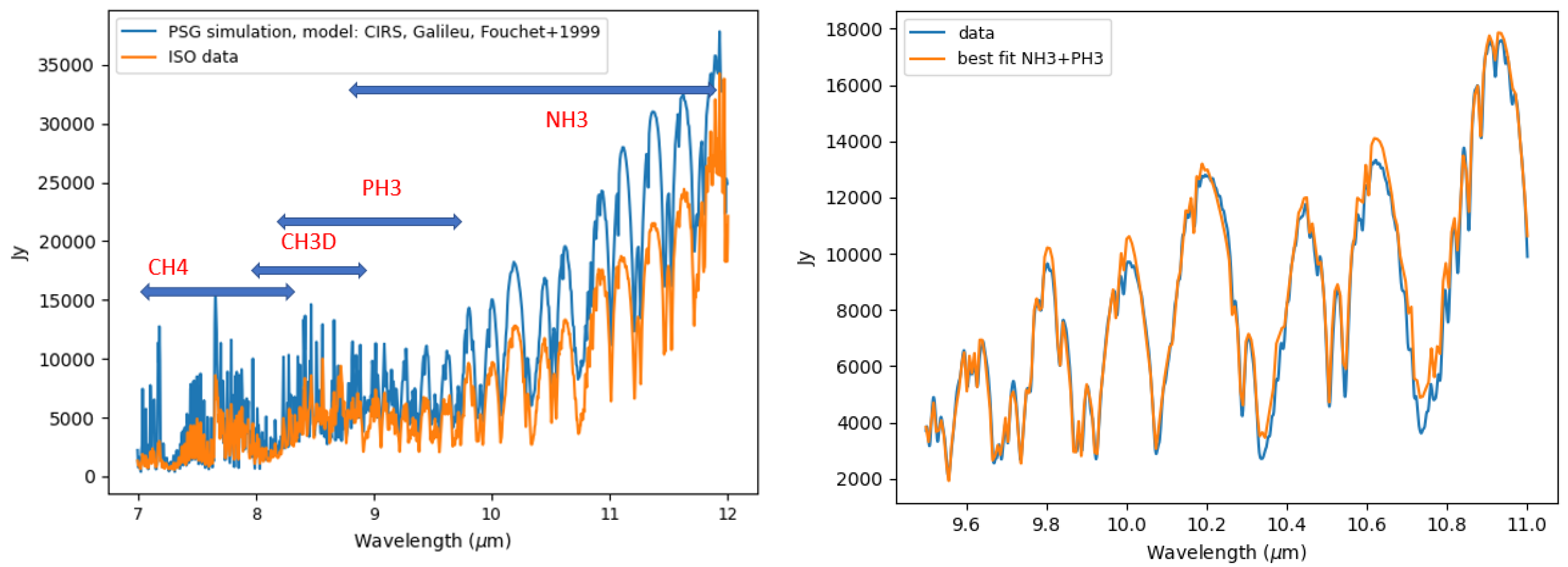
| Model/Methods | ldr (/) | Retrieval |
|---|---|---|
| VIRA-2 | 100–154 ppb | 109–118 ppb |
| LMD-VGCM | 20–43 ppb | 83–100 ppb |
| Observations ([23]) | 50–175 ppb |
| Line () | PSG | PSG Doppler Corrected | HITRAN |
|---|---|---|---|
| 1 | 955.271 ± 0.006 | 955.237 ± 0.006 | —955.233 ± 0.001 |
| 2 | 955.343 ± 0.006 | 955.308 ± 0.006 | —955.307 ± 0.001 |
| 3 | 955.403 ± 0.006 | 955.369 ± 0.006 | —955.3694 ± 0.0001 |
| Line () | PSG | HITRAN |
|---|---|---|
| 1— | 3004.00 ± 0.70 | —3004.68641 ± 0.00001 |
| 2—Solar Line | 3011.80 ± 0.70 | - |
| 3— | 3018.30 ± 0.70 | —3017.711713 ± 0.000001 |
| 4— | 3022.20 ± 0.70 | —3022.36627 ± 0.00001 |
| 5— | 3026.10 ± 0.70 | —3025.76099 ± 0.00001 |
Publisher’s Note: MDPI stays neutral with regard to jurisdictional claims in published maps and institutional affiliations. |
© 2022 by the authors. Licensee MDPI, Basel, Switzerland. This article is an open access article distributed under the terms and conditions of the Creative Commons Attribution (CC BY) license (https://creativecommons.org/licenses/by/4.0/).
Share and Cite
Dias, J.A.; Machado, P.; Ribeiro, J. From Atmospheric Evolution to the Search of Species of Astrobiological Interest in the Solar System—Case Studies Using the Planetary Spectrum Generator. Atmosphere 2022, 13, 461. https://doi.org/10.3390/atmos13030461
Dias JA, Machado P, Ribeiro J. From Atmospheric Evolution to the Search of Species of Astrobiological Interest in the Solar System—Case Studies Using the Planetary Spectrum Generator. Atmosphere. 2022; 13(3):461. https://doi.org/10.3390/atmos13030461
Chicago/Turabian StyleDias, João A., Pedro Machado, and José Ribeiro. 2022. "From Atmospheric Evolution to the Search of Species of Astrobiological Interest in the Solar System—Case Studies Using the Planetary Spectrum Generator" Atmosphere 13, no. 3: 461. https://doi.org/10.3390/atmos13030461
APA StyleDias, J. A., Machado, P., & Ribeiro, J. (2022). From Atmospheric Evolution to the Search of Species of Astrobiological Interest in the Solar System—Case Studies Using the Planetary Spectrum Generator. Atmosphere, 13(3), 461. https://doi.org/10.3390/atmos13030461








